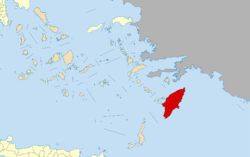Rhodian
|
Rhodes Ρόδος |
|
|---|---|

Palace of the Grand Master in the city of Rhodes
|
|
| Coordinates: 36°10′N 28°0′E / 36.167°N 28.000°ECoordinates: 36°10′N 28°0′E / 36.167°N 28.000°E | |
| Country | Greece |
| Administrative region | South Aegean |
| Regional unit | Rhodes |
| Area | |
| • Municipality | 1,401 km2 (541 sq mi) |
| Highest elevation | 1,216 m (3,990 ft) |
| Lowest elevation | 0 m (0 ft) |
| Population (2011) | |
| • Municipality | 115,490 |
| • Municipality density | 82/km2 (210/sq mi) |
| Time zone | EET (UTC+2) |
| • Summer (DST) | EEST (UTC+3) |
| Postal code | 85x xx |
| Area code(s) | 2241, 2244, 2246 |
| Vehicle registration | ΡΟ |
| Website | www.rhodes.gr |
Rhodes (Greek: Ρόδος, Ródos [ˈroðos]) is the largest of the Dodecanese islands in terms of land area and also the island group's historical capital. Administratively the island forms a separate municipality within the Rhodes regional unit, which is part of the South Aegean administrative region. The principal town of the island and seat of the municipality is Rhodes. The city of Rhodes had 50,636 inhabitants in 2011. It is located northeast of Crete, southeast of Athens and just off the Anatolian coast of Turkey. Rhodes' nickname is The island of the Knights, named after the Knights of Saint John of Jerusalem, who once conquered the land.
Historically, Rhodes was famous worldwide for the Colossus of Rhodes, one of the Seven Wonders of the Ancient World. The Medieval Old Town of the City of Rhodes has been declared a World Heritage Site. Today, it is one of the most popular tourist destinations in Europe.
The island has been known as Ρόδος in Greek throughout its history. In addition, the island has been called Rodi in Italian, Rodos in Turkish, and Rodi or Rodes in Ladino.
The Travels of Sir John Mandeville incorrectly reports that Rhodes was formerly called "Collosus", through a conflation of the Colossus of Rhodes and Paul's Epistle to the Colossians, which refers to Colossae.
...
Wikipedia


